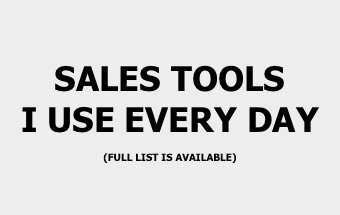This sales plan template is intended to help you sell more product. In fact, a lot more product. I’m going to outline the building blocks of the 4 primary steps in the sales process. Then provide you with examples of how to easily incorporate them into your own.
Now, we all know there is no seed that exists to grow a money tree. We have to grow them ourselves.
The good news is though… it’s possible to do this in sales. It’s possible to grow your own money tree in sales. Where customers hand you money day after day, month after month and year after year.
While we do this though, there’s one thing to keep in mind.
It’s not all about the money. It’s just a means to an end. Otherwise, you may end up rich but miserable.
Be sure to stop and smell the flowers along your way.
You’re better off selling a great product that makes customers really happy. Then help as many customers as possible.
The money will follow.
Simple Sales vs. Larger Sales
Now, before we jump into the sales plan template, I want to talk about the fundamental structure of the sales process. Because once we understand that, we can figure out how the building blocks fit together.
Here are the 2 fundamental stages in the sales process. The beginning and the end. There’s a moment where a real human being is first introduced to your product. Then a whole bunch of information is exchanged.
There’s a moment where a real human being is first introduced to your product. Then a whole bunch of information is exchanged.
And if all goes well, that person makes an order. Pretty simple process.
This dynamic exists in both simple sales and larger sales. The only difference is the complexity of what goes on between the two.
Let’s look at an example of a sales plan for a simple sale: Maybe you’ve personally experienced a sales plan like this before. You see the chocolate pretzels (intro).
Maybe you’ve personally experienced a sales plan like this before. You see the chocolate pretzels (intro).
Then you throw them in the basket to make your purchase (order). I know this stuff is so basic. Bare with me though.
With larger sales, there may be added complexity, but the fundamentals remain the same. The intro and the order. Here’s what a sales plan might look like for a larger sale:
Still the same beginning and end. More steps in between and often more money at the end.
For each of our products, there exists an optimized process. It’s really a matter of whether we discover it.
And that’s what today is all about. I’ll share with you a few sales ideas that could form the backbone of your perfect sales plan.
Be sure to test different methods. It’s the only way to discover what will work best for you.
How to Build Your Own
Sales Plan Template
The way I see it, there are 4 primary steps in the sales process. After you read them, sit down for a 1-2 hour strategy session to assemble the pieces of your own sales plan.
This is only the starting point. The hard work comes when you take action to experience the results for yourself.
#1 Build Your Sources of Leads
When you sell a product, you need some sources of leads. Lead sources can come from almost anywhere. I bet this covers 90% of them.
Consider which of these lead sources best fits your product:
- Advertising – Spend some money on paid advertising. Test both online and offline ( ad vs. highway billboard). Post a call to action, like “call this number” or “visit our website” or “join us on X date”.
- Conferences & Events – You can host your own event, sponsor an event or simply just purchase the attendee lists from events. Which would effectively still make you a sponsor.
- Content Marketing – Create blog posts, infographics, case studies, whitepapers, social media posts, videos, ebooks, etc. Optimize each piece of content for sharing. Then capture their lead info through forms, signups, popups, landing pages and many other ways. Neil Patel of KissMetrics, CrazyEgg and QuickSprout is absolutely brilliant at content marketing. And is very generous with his knowledge.
- Databases – You can buy lead lists. You tell them who you want to contact and they give you a list of companies and contacts. There’s a whole list of them on the sales tools page.
- Partnerships – Build partnerships with companies who can funnel leads to you. For example, have you ever seen the Safeway rewards program at the ExxonMobil? That’s a partnership. Gas for groceries.
- Referrals – Ask your customers who they know. This is one lead source I’m still trying to elegantly figure out myself. I’ll have more to share soon…
I wrote out exactly how to build a lead list. So, test out these different lead sources for yourself.
The right combination is there, you just have to find it.
#2 Contact Your Leads
Now that you have a bunch of leads, it’s time to contact them. There are many ways to communicate with humans. Choose an approach that takes into consideration where your lead came from.
How were they first introduced to you? Where are they in their buying process (if they even have one)?
Let’s look at the different ways to contact your leads:
- Conference Call – Use a conference call to communicate with multiple people. Join.me is quite simple, but there are plenty of different options available.
- Direct Mail – This seems less common these days. For the past 3 years, I have looked to find a way to incorporate MailLift into my sales process. What an elegant way to send hand written sales letters. If you’re interested in Direct Mail or really great sales copy in general, take a look at the .
- Email – Send your leads a cold email. Make it personal and valuable specifically to them. Send your leads an automated email. Maybe, every 3 months you send your leads an automated email to thank them for being customers. Keep it personal and talk directly to them.
- In Person – This is the best in larger sales. When you’re doing big, complicated deals there’s a lot at stake. And when a lot of resources are at stake, people want to know who they’re doing business with. For most simple sales, in-person is too costly. Hence, the rapidly growing number of inside sales jobs across the country.
- Phone Call – You know how this one works. Pick up the phone and call them. Hit them phones! All you need is a phone number and you can make magic happen.
- Social Media – Choose your social media channels wisely. Pick 2 or 3 and dominate them. The top 3 in my book are , and .
- Text – You have most likely experienced this yourself. An offer via text. That’s a sales pitch. I’ve never been pleased when I receive them, but figured I’d at least include it here.
- Video – Video technology keeps getting better and better. Companies like Zoom are giving us the power to have HD video conversations. It adds a personal touch when it may be too costly to drive or fly.
- Voicemail – Did you know you can start your own 900 number? You can record a voicemail, then charge callers to listen. I hear it’s most popular in the adult, fortune teller and self-help categories. You can also just leave a voicemail after you make a call. Keep it short: who you are, why they should call you back and how to call you back.
When I first started in sales, it felt very uncomfortable to contact a complete stranger about a product I was selling.
I still get butterflies from time to time, but it’s a lot more comfortable than it used to be 
Practice makes perfect for all of us.
#3 Schedule Sales Meetings
Your sales meetings are used to exchange information. Your leads need information to make a buying decision. And you need information to guide them toward a more prosperous future.
So, we must formulate a sequence of interactions where we can exchange the necessary information.
Here are different kinds of sales meetings you may need to properly exchange information:
- Cold Call – Every sales professional should learn to make cold calls. A scheduled call is better than a cold call. But sometimes, you need to make a cold call to get a scheduled call.
- Intro Call – This is the call you schedule via email, phone or a tool like Calendly. You just need 10-20 min for an intro call to understand if you can help them. If you can, sell them on step 2 in your process. If you can’t, guide them somewhere else.
- Discovery Call – Some would argue this is the most important part of the sales process. In simple sales, you may be able to squeeze discovery into the first 5-10 minutes of your demo. With larger sales, entire calls/meetings are dedicated to discovery.
- Demo – This is short for demonstration, as you know. Only demo to qualified leads. I have made this mistake too many times. It’s not a good use of either party’s time.
- Business Case Review – What’s the business case for doing business with you? It’s that simple. Much harder to effectively create, but simple in concept. Wikipedia explains it better than I would.
- Security Review – This mostly pertains to the technology industry. Essentially, the prospect needs to trust that their data isn’t at risk after buying your product.
- Pilot Kick-Off – Most people want to try before they buy, commonly known as a “trial” of “pilot”. Show them how to use your product, specifically to solve their own problems.
- Pilot Review Call – Of course, once you start a pilot, you want to make sure everything is going smoothly. Schedule a time to review the pilot progress.
- Closing Call – This is where you say, “show me the money!” Pretty straight forward. Get the final commitment, sign the paper work, then schedule next steps to deliver on your promises.
Maybe for your product sale, you only need one or two of these steps. For much larger sales, there are even more.
Think through the information your customer needs in order to make a decision. Then put a step-by-step plan in place to deliver them the right information, at the right time.
#4 Win the Deal
Business is about getting deals done. You ultimately have to win the deal.
Merriam Dictionary defines a deal as “an arrangement for mutual advantage”. In order to get your deals done, you’ll need enough bargaining chips to achieve a desired outcome. Often referred to as a WIN/WIN outcome.
Here are various terms within deals that offer both parties flexibility in negotiations. Figure out the minimum you will accept, the maximum they will accept, then double it.
I’m joking. It’s probably somewhere in between.
There are an infinite number of terms to negotiate. Consider taking advantage of these:
- Payment – Offer buyers multiple payment options. While charging fees or premiums for those payment methods less favorable for you. You have two factors to consider. Timing and amount. Timing could be today with a credit card or 30 days from now via invoice. Amount could be a one-time payment or a monthly subscription.
- Partner Perks – Similar to the ExxonMobil example above. Offer customers an added perk when they choose your product. You have probably seen hotels offer perks at their partner spa.
- Product – You can offer more of your product for the same price. More licenses, more units, more hours, more pounds, more whatever.
- Referrals – This has to be the best source of leads. And could be exchanged for something else of value in your deal. Good old fashion word of mouth is incredibly powerful in sales. Sometimes you just need to ask.
- Services – In addition to your product, maybe you can offer some additional services. Implementation services, training services, consultative services, etc.
- Testimonials – A positive testimonial from a reputable person at a reputable company is extremely persuasive. Why not ask for this as part of the deal? You may even want to ask to use their logo for marketing purposes.
As you know, the sales plan does not end after you take the order.
Service your customers. Build long lasting, trusted relationships. You customers will have many more problems to solve. Why not be the one to solve them?
Conclusion
This may seem pretty simple and fundamental. And that’s exactly what it is.
Success is neither magical nor mysterious. Success is the natural consequence of consistently applying the basic fundamentals. – Jim Rohn (click to tweet)
The building blocks for your sales plan template are here. Test them to discover what works best. I can’t think of anyone better positioned to figure it out than you.
What do you think?






7 Comments Sales Plan Template to Grow Your Own Money Tree